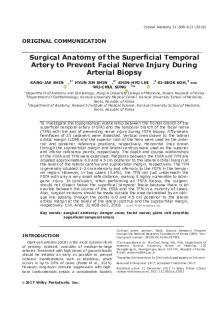Ca - Notes PDF

| Title | Ca - Notes |
|---|---|
| Author | Vivek Raja |
| Course | Computer Architecuture |
| Institution | Anna University |
| Pages | 10 |
| File Size | 612.9 KB |
| File Type | |
| Total Downloads | 5 |
| Total Views | 175 |
Summary
Notes...
Description
VELTECH MULTI TECH DR.RANGARAJAN DR.SAKUNTHALA ENGINEERING COLLEGE DEPARTMENT OF CSE CS8491 COMPUTER ARCHITECTURE EXERCISE PROBLEMS
1. numerical example of booth’s algorithm is shown below for n = 4. It shows the step by step multiplication of -5 and -7. MD = -5 = 1011, MD = 1011, MD'+1 = 0101 MR = -7 = 1001 The explanation of first step is as follows: Qn+1 AC = 0000, MR = 1001, Qn+1 = 0,
SC = 4
Qn Qn+1 = 10 So, we do AC + (MD)'+1, which gives AC = 0101 On right shifting AC and MR, we get AC = 0010, MR = 1100 and Qn+1 = 1 OPERATION
AC
MR
QN+1
SC
0000
1001
0
4
AC + MD’ + 1
0101
1001
0
ASHR
0010
1100
1
AC + MR
1101
1100
1
ASHR
1110
1110
0
2
ASHR
1111
0111
0
1
AC + MD’ + 1
0010
0011
1
0
3
Product is calculated as follows: Product = AC MR Product = 0010 0011 =
35
2. Multiply 14 times -5 using 5-bit numbers (10-bit result). 14 in binary: 01110 -14 in binary: 10010 (so we can add when we need to subtract the multiplicand) -5 in binary: 11011 Expected result: -70 in Multiplicand Action
Multiplier
binary: 11101 11010 Step 01110 01110
0 1
Initialization 10: Subtract Multiplicand
Shift Right Arithmetic 2 Shift Right Arithmetic 3
01110
11001 01101 1 11: No-op 11100 10110 1 01: Add Multiplicand
Shift Right Arithmetic 4
01110
00101 01011 0 10: Subtract Multiplicand
Shift Right Arithmetic 5 Shift Right Arithmetic
01110
11011 10101 1 11: No-op 11101 11010 1
01110
3.Perform Division Restoring Algorithm Dividend = 11 Divisor
= 3 N
4
3
2
M
A
Q
OPERATION
00011
00000
1011
initialize
00011
00001
011_
shift left AQ
00011
11110
011_
A=A-M
00011
00001
0110
Q[0]=0 And restore A
00011
00010
110_
shift left AQ
00011
11111
110_
A=A-M
00011
00010
1100
Q[0]=0
00011
00101
100_
shift left AQ
00011
00010
100_
A=A-M
upper 5-bits 0, lower 5-bits multiplier, 1 “Booth bit” initially 0 00000 11011 0 00000+10010=10010 10010 11011 0 11001 01101 1 11100+01110=01010 (Carry ignored because adding a positive and negative number cannot overflow.) 01010 10110 1 00101+10010=10111 10111 01011 0 11011 10101 1
N
1
M
A
Q
OPERATION
00011
00010
1001
Q[0]=1
00011
00101
001_
shift left AQ
00011
00010
001_
A=A-M
00011
00010
0011
Q[0]=1
4. In this problem, Dividend (A) = 101110, ie 46, and Divisor (B) = 010111, ie 23.
Initialization : Set Register A = Dividend = 000000 Set Register Q = Dividend = 101110 ( So AQ = 000000 101110 , Q0 = LSB of Q = 0 ) Set M = Divisor = 010111, M' = 2's complement of M = 101001 Set Count = 6, since 6 digits operation is being done here.
After this we start the algorithm, which I have shown in a table below : In table, SHL(AQ) denotes shift left AQ by one position leaving Q0 blank. Similarly, a square symbol in Q0 position denote, it is to be calculated later
5. Example addition in binary Perform 0.5
+ (-0.4375) 0.5 = 0.1 × 20 = 1.000 × 2-1
(normalised)
-0.4375 = -0.0111 × 20 = -1.110 × 2-2
(normalised)
1. Rewrite the smaller number such that its exponent matches with the exponent of the larger number. -1.110 × 2-2 = -0.1110 × 2-1
2. Add the mantissas: 1.000 × 2-1 + -0.1110 × 2-1 = 0.001 × 2-1
3. Normalise the sum, checking for overflow/underflow: 0.001 × 2-1 = 1.000 × 2-4 -126 (-3 + 127)
2. Multiply the mantissas 1.000 × 1.110 ----------0000 1000 1000 + 1000 ----------1110000
===> 1.110000
The product is 1.110000 × 2-3 Need to keep it to 4 bits 1.110 × 2-3
3. Normalise (already normalised) At this step check for overflow/underflow by making sure that -126...
Similar Free PDFs

Ca - Notes
- 10 Pages

Ca - notes
- 6 Pages

CS8491 CA - Lecture notes 5
- 2 Pages

Convertidores ca ca - Nota: 5
- 3 Pages

Ca colon
- 27 Pages

Shakespeare CA
- 10 Pages

AUDIT NOTES OF CA KAPIL GOYAL
- 23 Pages

Chua vs CA - Lecture notes Sales
- 1 Pages

Ca cervix
- 25 Pages

Ca CO3 HCl - Lecture notes 1
- 2 Pages

Crimenes.para.resolver CA
- 143 Pages

CA OVARIUM
- 37 Pages

Ca Paru
- 46 Pages

CA ENDOMETRIUM
- 11 Pages
Popular Institutions
- Tinajero National High School - Annex
- Politeknik Caltex Riau
- Yokohama City University
- SGT University
- University of Al-Qadisiyah
- Divine Word College of Vigan
- Techniek College Rotterdam
- Universidade de Santiago
- Universiti Teknologi MARA Cawangan Johor Kampus Pasir Gudang
- Poltekkes Kemenkes Yogyakarta
- Baguio City National High School
- Colegio san marcos
- preparatoria uno
- Centro de Bachillerato Tecnológico Industrial y de Servicios No. 107
- Dalian Maritime University
- Quang Trung Secondary School
- Colegio Tecnológico en Informática
- Corporación Regional de Educación Superior
- Grupo CEDVA
- Dar Al Uloom University
- Centro de Estudios Preuniversitarios de la Universidad Nacional de Ingeniería
- 上智大学
- Aakash International School, Nuna Majara
- San Felipe Neri Catholic School
- Kang Chiao International School - New Taipei City
- Misamis Occidental National High School
- Institución Educativa Escuela Normal Juan Ladrilleros
- Kolehiyo ng Pantukan
- Batanes State College
- Instituto Continental
- Sekolah Menengah Kejuruan Kesehatan Kaltara (Tarakan)
- Colegio de La Inmaculada Concepcion - Cebu

